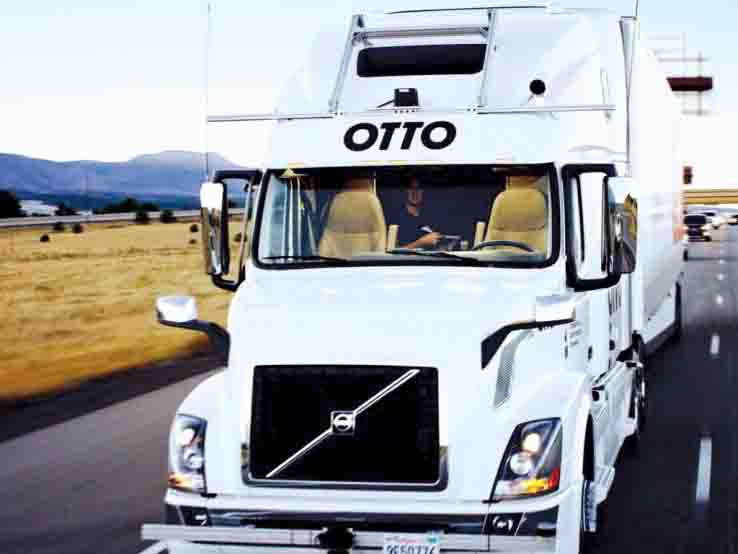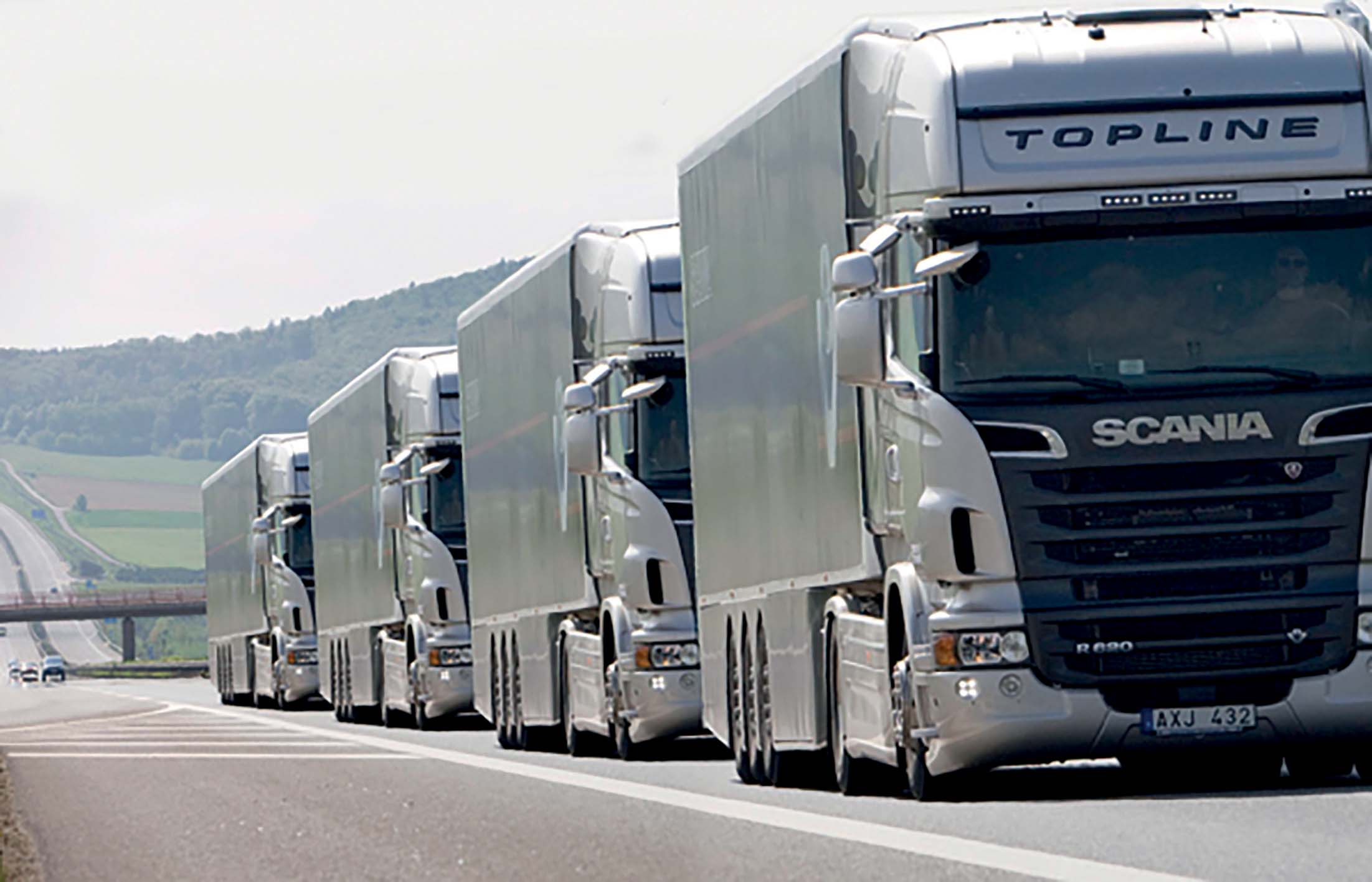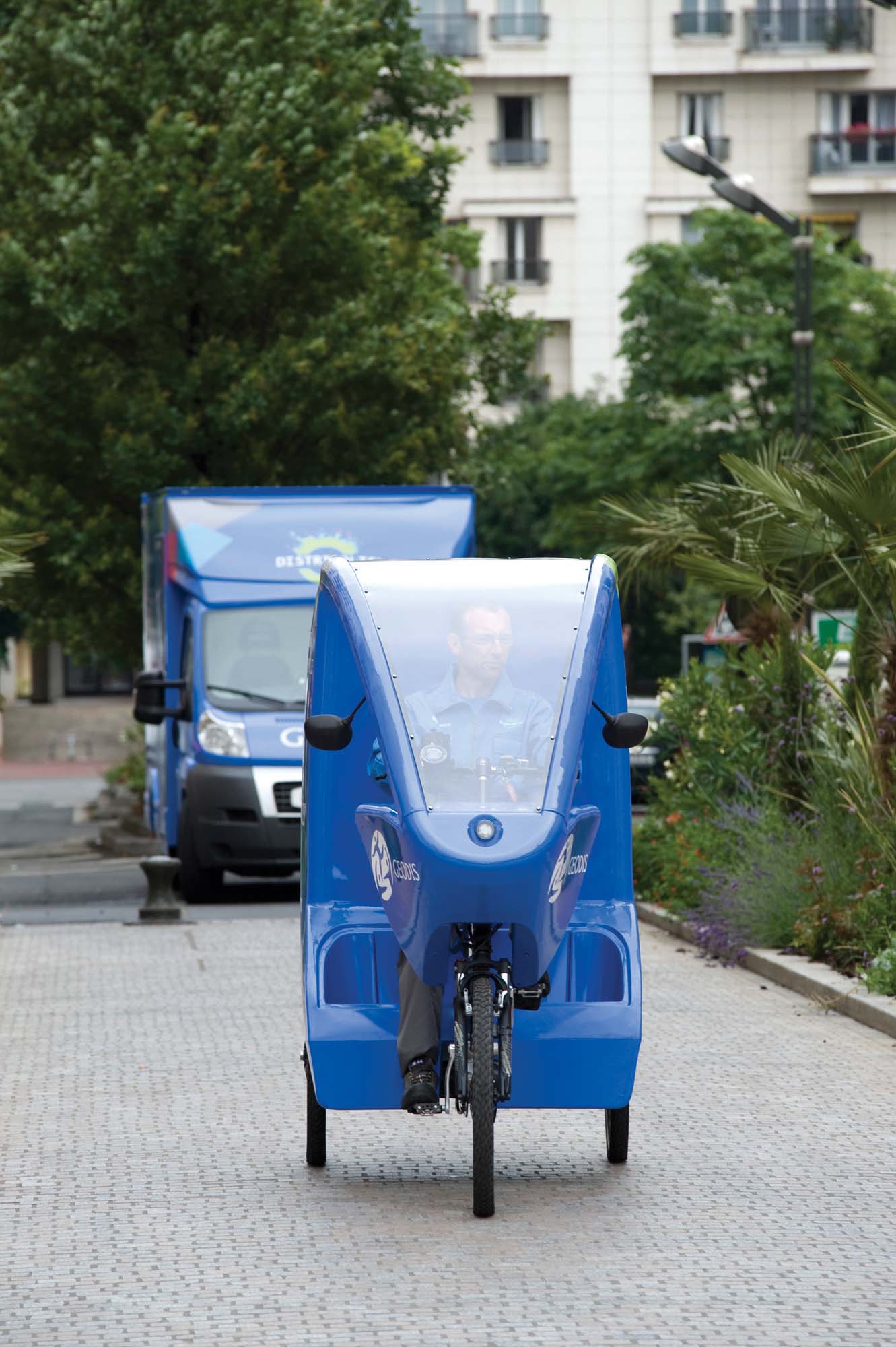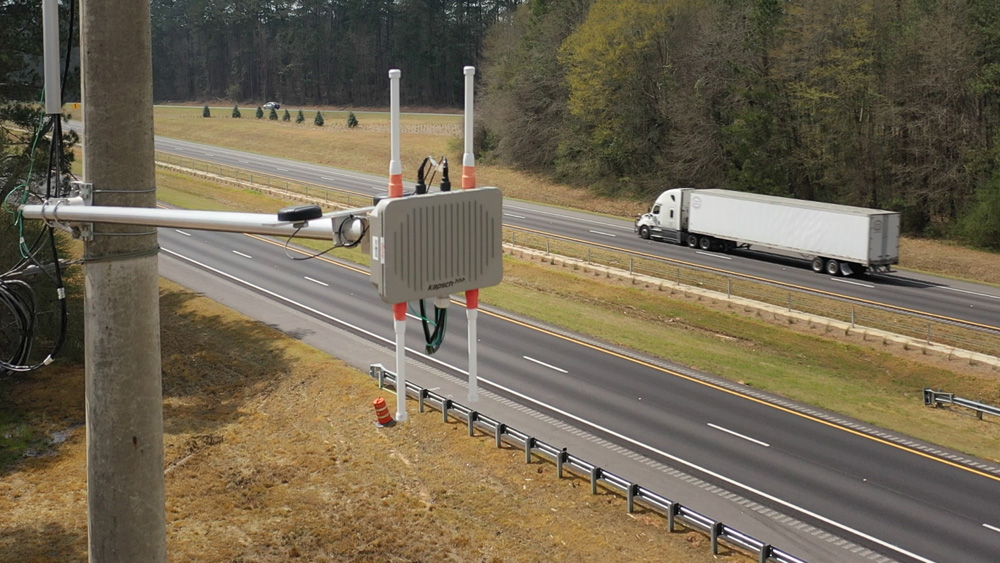Wes Guckert considers possible solutions and countermeasures to the problems of increased freight deliveries in growing cities.
In January 2016, the US Department of Transportation (USDoT) conducted a session on the SmartCity Challenge and Urban Freight and Logistics. This session was a follow-up to the USDoT report titled, Beyond Traffic 2045.

The Otto self-driving truck recently completed a 190km trip across Colorado.
Wes Guckert considers possible solutions and countermeasures to the problems of increased freight deliveries in growing cities.
In January 2016, the324 US Department of Transportation (USDoT) conducted a session on the SmartCity Challenge and Urban Freight and Logistics. This session was a follow-up to the USDoT report titled, Beyond Traffic 2045.
The SmartCity Challenge encourages cities to put forward their best and most creative ideas for innovatively addressing their particular transit challenges. This is no small undertaking. Specifically, the USDoT is looking for cities to come up with cutting-edge ways of integrating emerging transportation data, technologies and applications with a city’s existing systems to deal with transportation challenges. The catch is that these solutions have to simultaneously reduce congestion, keep travellers safe, protect the environment, connect underserved communities and support economic vitality.
One important aspect of the SmartCity Challenge is focused on urban delivery and logistics. More than 80% of goods in the US either start or end in the country’s largest 100 metro areas and 10% of America’s trade corridors carry 79% of all goods. Once again, the 80/20 rule is in play.
In 2010, $16.2 trillion of $20.3 trillion in goods movement occurred in these top 100 metro areas. As populations increase and urbanisation continues, the USDoT indicates that these cities will need to identify innovative ways to effectively and efficiently move goods - food, energy and manufactured products - into these cities.
Due to a shortage of 48,000+ truck drivers, the logistical movement of goods will change dramatically over the next five to 10 years. Exacerbating this problem even further is the fact that the average age of current drivers is 55 years old. The long-haul trucking industry is currently able to hire anyone who passes the tests regardless of age. The trucking industry is ripe for self-driving travel. All we need to do is look at the8336 Uber-owned Otto truck, which recently completed a 190km (120 miles) trip across Colorado to deliver Budweiser beer. Logically, it is better to use automated trucks for the longer ‘out of town’ runs (where there is no rail or other option) and use the available drivers for that first/last mile.
Given these stats, what is a viable solution? As usual, there will not be a single solution but major advances can be made by simply utilising connected vehicle technology (or V2X) for trucks. Examples of V2X safety applications include forward collision warning, lane change warning, intersection movement assist and electronic emergency braking.
Other safety applications include dynamic speed limits, variable truck speed limits and dynamic truck restrictions including wind warning for high profile vehicles. These will be infrastructure-mounted signs but will increasingly include both in-cab warnings and ultimately automatic V2Xbased speed limiting.
Additional safety functions include at-grade rail crossing where an in-cab warning alerts drivers of an approaching train – particularly at crossings that are not equipped with warning lights. When the train passes a certain point a transmitter can be activated to trigger the warning in the truck cab about the approaching train and the potential risk of collision. Alternatively, the train itself could be equipped with a transmitter. Curve warning allows connected vehicles to receive information on the recommended speed when a truck is approaching a curve. In addition, over-height detection warns drivers, perhaps with a heads-up display, that they are heading toward an obstacle they cannot clear, such as a bridge or tunnel. Weigh-in-motion technology will be used to detect overweight vehicles approaching weak bridges and for enforcement if they continue across that bridge.
Finally, there is a huge challenge dealing with weather-related safety. Approximately 22% of all vehicle crashes occur in adverse weather, such as rain, sleet, snow, fog, severe cross winds, or blowing sand and debris. While this figure is hard to comprehend, each year, trucking companies lose an estimated 32 billion vehicle hours due to weather-related congestion in almost 300 of the nation’s metropolitan areas. The estimated cost of weather-related delays to trucking companies ranges from $2.2 billion to $3.5 billion annually!
Increasing freight demand in these densely populated areas will complicate ‘first mile’ movement of goods out of ports and the ‘last mile’ movement of goods from freight hubs to the final destinations. According to the report, by 2040 nearly 30,000 miles of America’s busiest highways will be clogged on a daily basis. Even today, truck congestion wastes $27 billion in time and fuel annually.
Consolidation centres on the outskirts of a city are now being considered - including mega-sized warehouses with smaller decentralised warehouses inside the city. Heavy commercial vehicles will carry goods to big warehouses on the edge of the city and from there, medium and light commercial vehicles will deliver goods to a smaller warehouse within a city or directly to their destination. These smaller vehicles may include electric vehicles and, in the future, smaller, driverless vehicles or shared-use vehicles and could operate out of peak hours.
Additional solutions could see the repurposing of existing single-level facilities into two or three storey warehouses and storage facilities. This already exists in Europe and at the beginning of November Prologis announced that it is planning its first three-storey urban warehouse in the Seattle area.
Downstream, the use of dynamic routing communication - message signs, highway advisory radio and truck-specific 511 - will be essential. Dynamic guiding and re-routing opportunities are expected to be based on real-time conditions and may use dynamic road pricing to smooth out demand and reduce congestion during peak times by encouraging truck drivers onto less congested alternative routes. The use of electric and alternative fuel vehicles will see a significant reduction in vehicle noise which will reduce opposition to overnight deliveries although the issue of noise related to slamming tail lifts, colliding stills and other manual handling will still need to be addressed.
Urban parking will continue to be a challenge for trucks. Lanes being blocked by double-parked delivery vehicles are already becoming a problem. Currently, there is a lack of enforcement dealing with this issue and cities are not getting to grips with the problem. As freight demand increases, unless out-of-hours deliveries are adopted, additional parking for trucks will need to be made available - meaning less parking for cars. It will be necessary to figure out a way to limit parking for delivery (and other) vehicles that are parked in loading zones. For long-haul trucking, parking shortages and the limited parking information for trucks need to be improved. Smart truck and dynamic truck parking and information need to be provided through websites, mobile apps and connected vehicle technologies.
Technology is providing the transportation industry with opportunities to improve urban freight and logistics in all metropolitan areas. We need to continue to innovate and implement the technologies that are available today – so we can move goods from Point A to Point B tomorrow. At a recent symposium in Detroit, I came away with a few new catchphrases that could not be more appropriate. With the transit challenges we are currently facing, it is important to ‘rethink everything’ as well as ‘Uber yourself, before you are Kodaked.’ Certainly words to remember.
In January 2016, the
The SmartCity Challenge encourages cities to put forward their best and most creative ideas for innovatively addressing their particular transit challenges. This is no small undertaking. Specifically, the USDoT is looking for cities to come up with cutting-edge ways of integrating emerging transportation data, technologies and applications with a city’s existing systems to deal with transportation challenges. The catch is that these solutions have to simultaneously reduce congestion, keep travellers safe, protect the environment, connect underserved communities and support economic vitality.
One important aspect of the SmartCity Challenge is focused on urban delivery and logistics. More than 80% of goods in the US either start or end in the country’s largest 100 metro areas and 10% of America’s trade corridors carry 79% of all goods. Once again, the 80/20 rule is in play.
In 2010, $16.2 trillion of $20.3 trillion in goods movement occurred in these top 100 metro areas. As populations increase and urbanisation continues, the USDoT indicates that these cities will need to identify innovative ways to effectively and efficiently move goods - food, energy and manufactured products - into these cities.
Due to a shortage of 48,000+ truck drivers, the logistical movement of goods will change dramatically over the next five to 10 years. Exacerbating this problem even further is the fact that the average age of current drivers is 55 years old. The long-haul trucking industry is currently able to hire anyone who passes the tests regardless of age. The trucking industry is ripe for self-driving travel. All we need to do is look at the
The safety challenge
Safety remains one of the greatest challenges in the movement of goods by trucks. Both crashes and vehicle-related fatalities are on the rise and trucks are not exempt. Unfortunately, freight transportation is involved in approximately 13% of all road transport fatalities. The need to transport increasing amounts of freight to large urban areas in the future could further increase freight and passenger accidents.Given these stats, what is a viable solution? As usual, there will not be a single solution but major advances can be made by simply utilising connected vehicle technology (or V2X) for trucks. Examples of V2X safety applications include forward collision warning, lane change warning, intersection movement assist and electronic emergency braking.
Other safety applications include dynamic speed limits, variable truck speed limits and dynamic truck restrictions including wind warning for high profile vehicles. These will be infrastructure-mounted signs but will increasingly include both in-cab warnings and ultimately automatic V2Xbased speed limiting.
Additional safety functions include at-grade rail crossing where an in-cab warning alerts drivers of an approaching train – particularly at crossings that are not equipped with warning lights. When the train passes a certain point a transmitter can be activated to trigger the warning in the truck cab about the approaching train and the potential risk of collision. Alternatively, the train itself could be equipped with a transmitter. Curve warning allows connected vehicles to receive information on the recommended speed when a truck is approaching a curve. In addition, over-height detection warns drivers, perhaps with a heads-up display, that they are heading toward an obstacle they cannot clear, such as a bridge or tunnel. Weigh-in-motion technology will be used to detect overweight vehicles approaching weak bridges and for enforcement if they continue across that bridge.
Finally, there is a huge challenge dealing with weather-related safety. Approximately 22% of all vehicle crashes occur in adverse weather, such as rain, sleet, snow, fog, severe cross winds, or blowing sand and debris. While this figure is hard to comprehend, each year, trucking companies lose an estimated 32 billion vehicle hours due to weather-related congestion in almost 300 of the nation’s metropolitan areas. The estimated cost of weather-related delays to trucking companies ranges from $2.2 billion to $3.5 billion annually!
Increased demand
According to the USDoT, our nation’s freight system is a multi-modal engine that we depend on to drive our country’s economy. The Beyond Traffic 2045 report expects goods movements by truck to increase by 43% between 2012 and 2040.Increasing freight demand in these densely populated areas will complicate ‘first mile’ movement of goods out of ports and the ‘last mile’ movement of goods from freight hubs to the final destinations. According to the report, by 2040 nearly 30,000 miles of America’s busiest highways will be clogged on a daily basis. Even today, truck congestion wastes $27 billion in time and fuel annually.
Consolidation centres on the outskirts of a city are now being considered - including mega-sized warehouses with smaller decentralised warehouses inside the city. Heavy commercial vehicles will carry goods to big warehouses on the edge of the city and from there, medium and light commercial vehicles will deliver goods to a smaller warehouse within a city or directly to their destination. These smaller vehicles may include electric vehicles and, in the future, smaller, driverless vehicles or shared-use vehicles and could operate out of peak hours.
Additional solutions could see the repurposing of existing single-level facilities into two or three storey warehouses and storage facilities. This already exists in Europe and at the beginning of November Prologis announced that it is planning its first three-storey urban warehouse in the Seattle area.
Downstream, the use of dynamic routing communication - message signs, highway advisory radio and truck-specific 511 - will be essential. Dynamic guiding and re-routing opportunities are expected to be based on real-time conditions and may use dynamic road pricing to smooth out demand and reduce congestion during peak times by encouraging truck drivers onto less congested alternative routes. The use of electric and alternative fuel vehicles will see a significant reduction in vehicle noise which will reduce opposition to overnight deliveries although the issue of noise related to slamming tail lifts, colliding stills and other manual handling will still need to be addressed.
Urban parking will continue to be a challenge for trucks. Lanes being blocked by double-parked delivery vehicles are already becoming a problem. Currently, there is a lack of enforcement dealing with this issue and cities are not getting to grips with the problem. As freight demand increases, unless out-of-hours deliveries are adopted, additional parking for trucks will need to be made available - meaning less parking for cars. It will be necessary to figure out a way to limit parking for delivery (and other) vehicles that are parked in loading zones. For long-haul trucking, parking shortages and the limited parking information for trucks need to be improved. Smart truck and dynamic truck parking and information need to be provided through websites, mobile apps and connected vehicle technologies.
Environmental issues
Greenhouse gas emissions have continued to grow since 1992. Heavy, on-road trucks are responsible for most of the growth in the greenhouse gas emissions in the freight sector. Reducing congestion for heavy trucks, where there is recurring congestion, is going to be vital in reducing all greenhouse gas emissions.Technology is providing the transportation industry with opportunities to improve urban freight and logistics in all metropolitan areas. We need to continue to innovate and implement the technologies that are available today – so we can move goods from Point A to Point B tomorrow. At a recent symposium in Detroit, I came away with a few new catchphrases that could not be more appropriate. With the transit challenges we are currently facing, it is important to ‘rethink everything’ as well as ‘Uber yourself, before you are Kodaked.’ Certainly words to remember.











